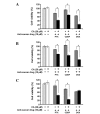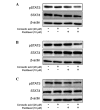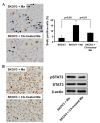Corosolic acid enhances the antitumor effects of chemotherapy on epithelial ovarian cancer by inhibiting signal transducer and activator of transcription 3 signaling
- PMID: 24260055
- PMCID: PMC3834045
- DOI: 10.3892/ol.2013.1591
Corosolic acid enhances the antitumor effects of chemotherapy on epithelial ovarian cancer by inhibiting signal transducer and activator of transcription 3 signaling
Abstract
Resistance to chemotherapy poses a serious problem for the treatment of advanced epithelial ovarian cancer patients. The mechanisms of chemoresistance are complex and studies have implicated signal transducer and activator of transcription 3 (STAT3) signaling in the chemoresistance of cancer cells. The present study investigated whether corosolic acid (CA), which has been previously reported to be a STAT3 inhibitor, was able to increase the sensitivity to chemotherapeutic drugs in epithelial ovarian cancer cells. CA also markedly enhanced the anticancer effect of paclitaxel, cisplatin and doxorubicin. In addition, CA abrogated the cell-cell interactions between macrophages and epithelial ovarian cancer cells and inhibited the macrophage-induced activation of epithelial ovarian cancer cells. These data indicated that CA was able to reverse the chemoresistance of epithelial ovarian cancer cells and suppress the cell-cell interaction with tumorigenic macrophages. Thus, CA may be useful as an adjuvant treatment to patients with advanced ovarian and other types of cancer due to the multiple anticancer effects.
Keywords: corosolic acid; macrophage; ovarian cancer; signal transducer and activator of transcription 3.
Figures





Similar articles
-
A potent oncolytic adenovirus selectively blocks the STAT3 signaling pathway and potentiates cisplatin antitumor activity in ovarian cancer.Hum Gene Ther. 2012 Jan;23(1):32-45. doi: 10.1089/hum.2011.101. Epub 2011 Oct 14. Hum Gene Ther. 2012. PMID: 21875334
-
A novel small molecule LLL12B inhibits STAT3 signaling and sensitizes ovarian cancer cell to paclitaxel and cisplatin.PLoS One. 2021 Apr 28;16(4):e0240145. doi: 10.1371/journal.pone.0240145. eCollection 2021. PLoS One. 2021. PMID: 33909625 Free PMC article.
-
Diindolylmethane suppresses ovarian cancer growth and potentiates the effect of cisplatin in tumor mouse model by targeting signal transducer and activator of transcription 3 (STAT3).BMC Med. 2012 Jan 26;10:9. doi: 10.1186/1741-7015-10-9. BMC Med. 2012. PMID: 22280969 Free PMC article.
-
CD44 in Ovarian Cancer Progression and Therapy Resistance-A Critical Role for STAT3.Front Oncol. 2020 Dec 1;10:589601. doi: 10.3389/fonc.2020.589601. eCollection 2020. Front Oncol. 2020. PMID: 33335857 Free PMC article. Review.
-
Chemoresistance in Ovarian Cancer: Prospects for New Drugs.Anticancer Agents Med Chem. 2021;21(6):668-678. doi: 10.2174/1871520620666200908104835. Anticancer Agents Med Chem. 2021. PMID: 32900355 Review.
Cited by
-
Corosolic acid inhibits the proliferation of osteosarcoma cells by inducing apoptosis.Oncol Lett. 2016 Nov;12(5):4187-4194. doi: 10.3892/ol.2016.5185. Epub 2016 Sep 26. Oncol Lett. 2016. PMID: 27895790 Free PMC article.
-
Anti-Diabetic Potential of Plant-Based Pentacyclic Triterpene Derivatives: Progress Made to Improve Efficacy and Bioavailability.Molecules. 2021 Nov 29;26(23):7243. doi: 10.3390/molecules26237243. Molecules. 2021. PMID: 34885816 Free PMC article. Review.
-
Biological effects of corosolic acid as an anti-inflammatory, anti-metabolic syndrome and anti-neoplasic natural compound.Oncol Lett. 2021 Feb;21(2):84. doi: 10.3892/ol.2020.12345. Epub 2020 Dec 2. Oncol Lett. 2021. PMID: 33363621 Free PMC article. Review.
-
Antitumor effects of baicalin on ovarian cancer cells through induction of cell apoptosis and inhibition of cell migration in vitro.Mol Med Rep. 2017 Dec;16(6):8729-8734. doi: 10.3892/mmr.2017.7757. Epub 2017 Oct 10. Mol Med Rep. 2017. PMID: 29039573 Free PMC article.
-
The role of macrophage polarization in ovarian cancer: from molecular mechanism to therapeutic potentials.Front Immunol. 2025 Apr 22;16:1543096. doi: 10.3389/fimmu.2025.1543096. eCollection 2025. Front Immunol. 2025. PMID: 40330466 Free PMC article. Review.
References
-
- Okamura H, Katabuchi H. Pathophysiological dynamics of human ovarian surface epithelial cells in epithelial ovarian carcinogenesis. Int Rev Cytol. 2005;242:1–54. - PubMed
-
- Yu H, Kortylewski M, Pardoll D. Crosstalk between cancer and immune cells: role of STAT3 in the tumour microenvironment. Nat Rev Immunol. 2007;7:41–51. - PubMed
LinkOut - more resources
Full Text Sources
Other Literature Sources
Miscellaneous
